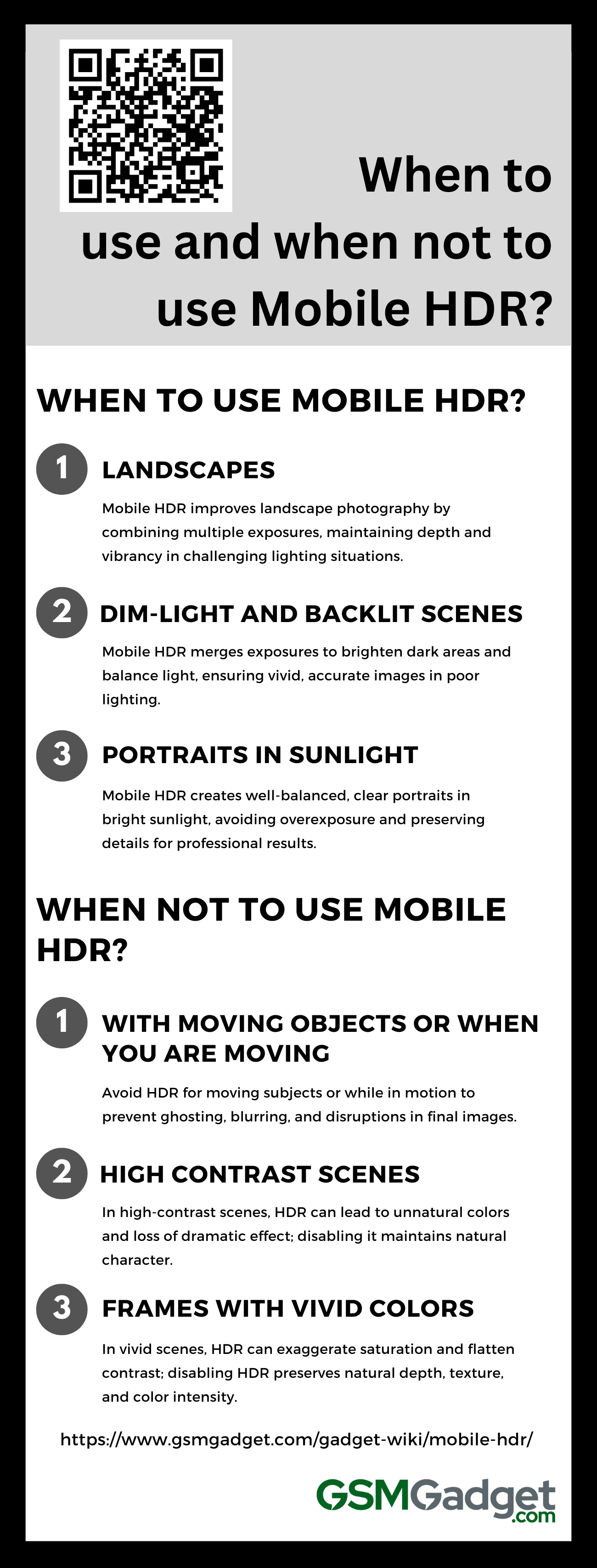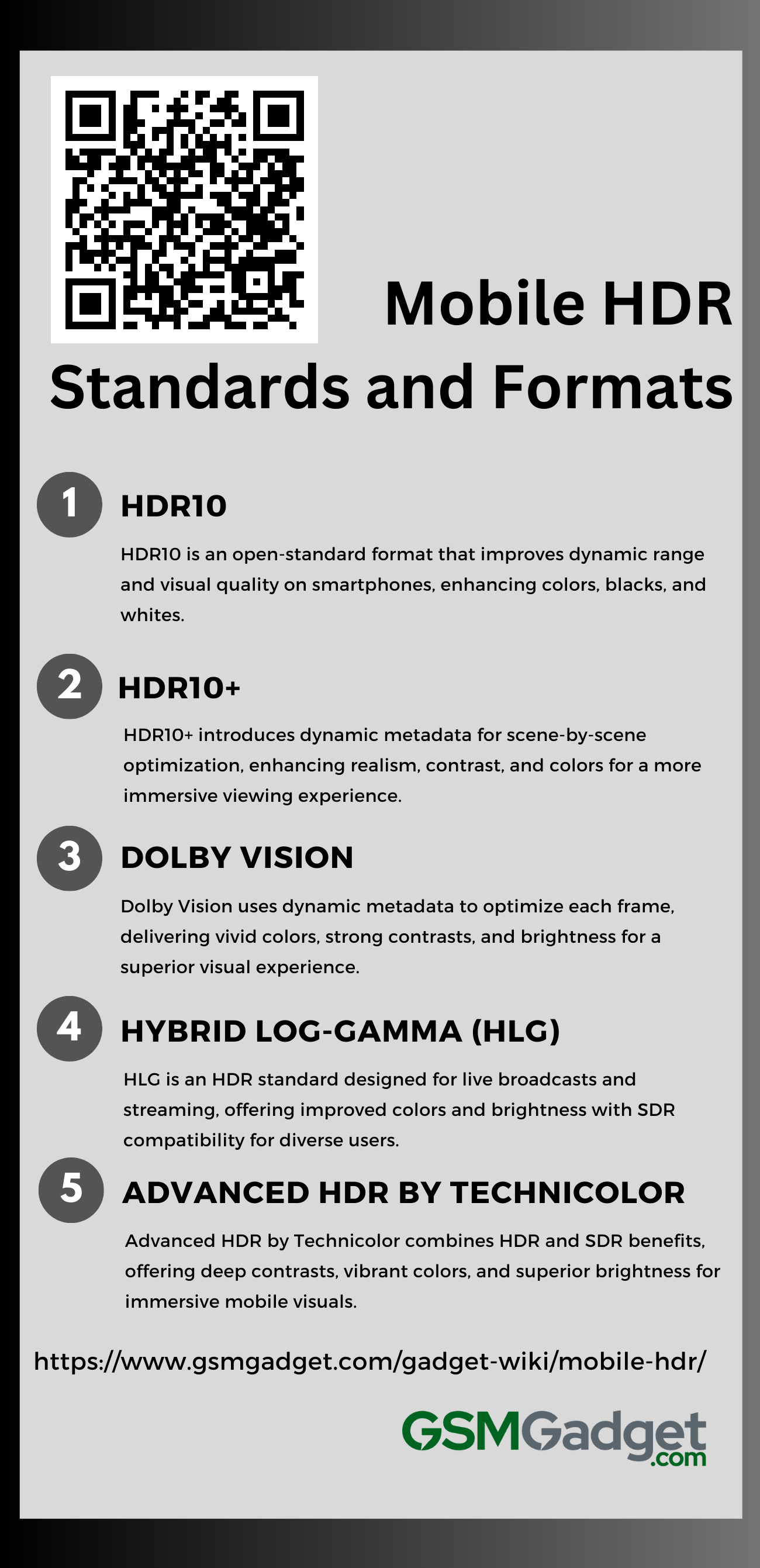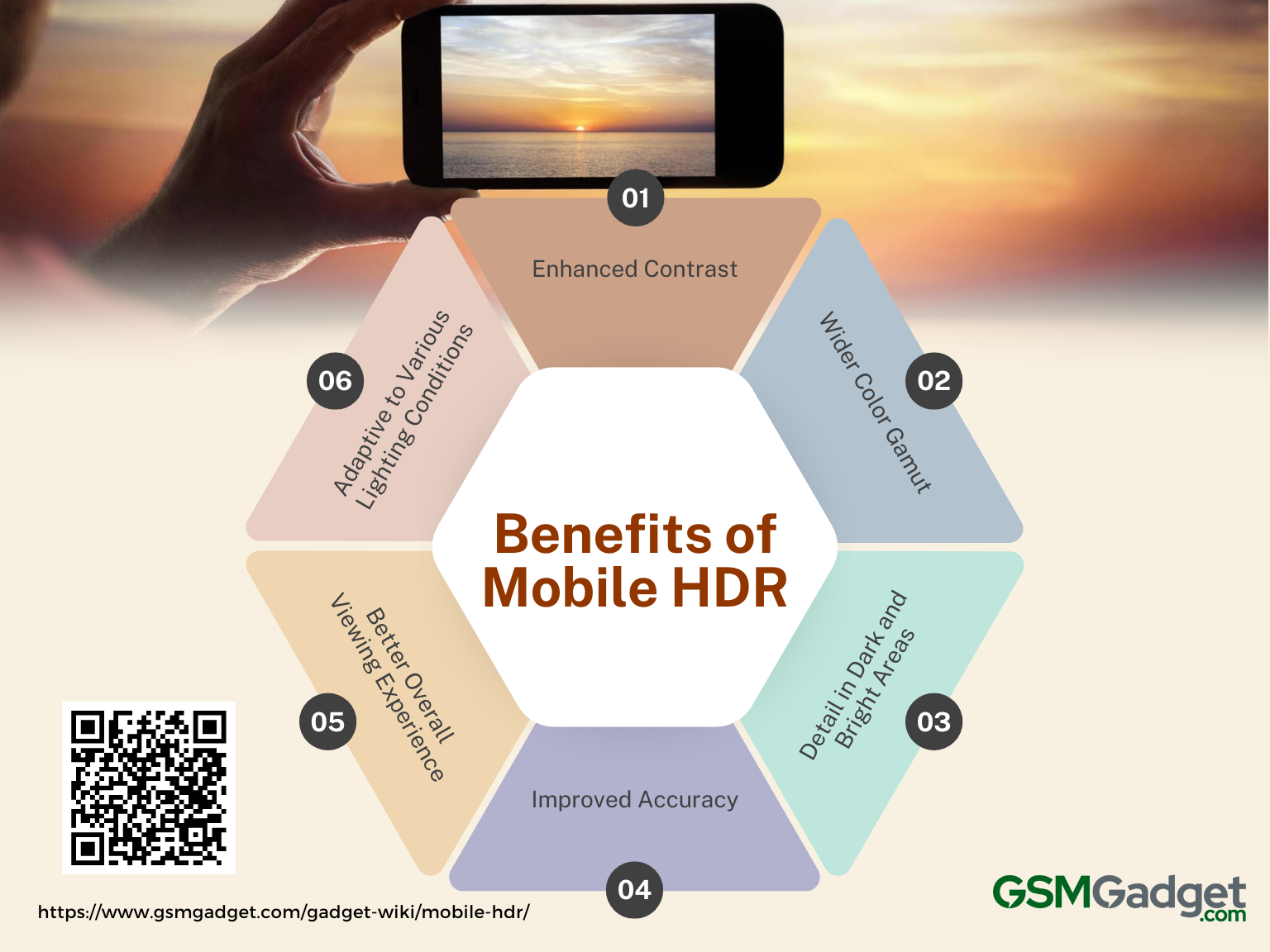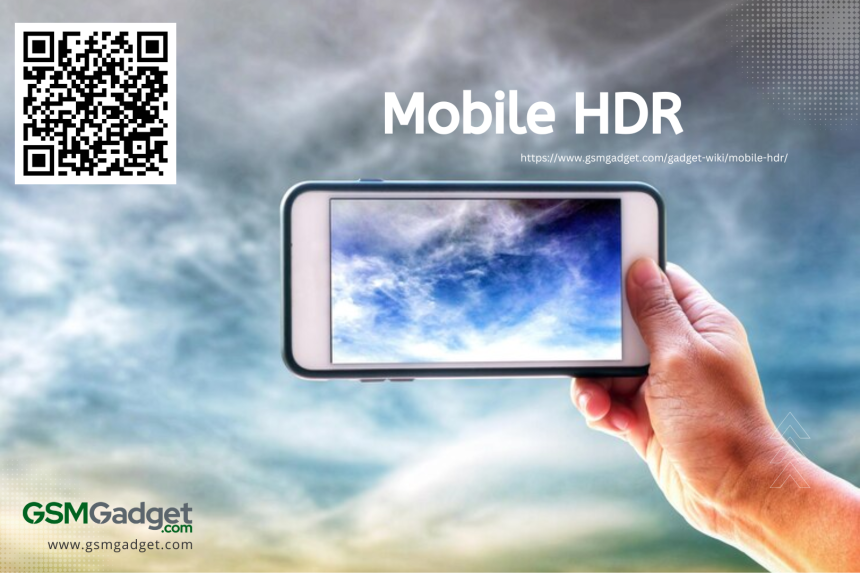Mobile HDR, or High Dynamic Range technology, has revolutionized the visual display capabilities of smartphones, providing users with an immersive experience that closely replicates the dynamic range of the real world. This innovative feature improves the contrast and color accuracy of your mobile device’s screen, resulting in brighter whites, deeper blacks, and a wider color spectrum. Consequently, images, videos, and games are displayed with a level of detail and vibrancy previously only seen on high-end TVs. The integration of Mobile HDR ensures that content is displayed with greater clarity, offering a more engaging and realistic viewing experience. Despite its advanced performance, delivering HDR video on mobile devices is resource-efficient, requiring only slightly more resources than standard LDR content.
Technical Specifications of Mobile HDR
| Specification | Description |
| Display Types | OLED- AMOLED- Super AMOLED- IPS LCD |
| Resolution Options | Full HD: 1920×1080 pixels
Quad HD: 2560×1440 pixels 4K UHD: 3840×2160 pixels |
| HDR Standards | HDR10, HDR10+, Dolby Vision, HLG |
| Color Depth | 10-bit or more, allowing for over a billion colors |
| Peak Brightness | Minimum 550-600 nits for true HDR experience; high-end devices may exceed 1000 nits |
| Contrast Ratio | A higher ratio indicates deeper blacks and brighter whites; essential for a true HDR experience |
| Color Gamut | DCI-P3: Covers a wider range of colors compared to traditional sRGB- Rec. 2020: Even broader color space for future-proof content |
| Certifications | UHD Alliance Mobile HDR Premium: Ensures a high-quality HDR experience on mobile devices VESA Display HDR: A performance standard for HDR displays |
| Content Compatibility | Wide compatibility with HDR content from various streaming services and platforms |
| Battery Consumption | Generally higher power consumption due to increased brightness and processing requirements |
| Camera HDR Support | Real-time HDR photo and video capture capabilities for enhanced imaging |
Which smartphone models are equipped with HDR?
High Dynamic Range (HDR) technology has significantly elevated the visual experience on smartphone displays, offering users richer colors, superior contrast, and a more immersive multimedia experience. With the advancement of technology, a growing array of smartphones now feature HDR compatibility, catering to the demand for high-fidelity visuals in videos and images.
1. iOS phones with HDR
Apple has been a leader in incorporating HDR technology, starting with the iPhone 8 and iPhone X, and continuing through the iPhone XR, XS, 11, 12, 13, and the latest iPhone 14 series. These iOS devices not only support HDR10 but also Dolby Vision, allowing for a wider color range and deeper contrast that enhances photos, videos, and streaming content. The iPad Pro, starting from its 3rd generation, also includes HDR capabilities, expanding the appeal for mobile app developers and everyday users seeking media with superior clarity and color accuracy. Apple’s commitment to HDR technology ensures that users can enjoy cinematic-quality video directly from their devices, enhancing each viewing experience with dynamic and visually compelling content.
2. Android phones with HDR
Samsung’s Galaxy S21 series leads the way with HDR10+ displays that offer a visually stunning experience. Google’s Pixel lineup, including the Pixel 5 with its OLED screen, delivers HDR content with exceptional detail, deep blacks, and vivid colors. OnePlus competes with its OnePlus 9 Pro, which features HDR10+ capabilities, while Sony’s Xperia 1 II targets movie buffs with its 4K HDR OLED display. Xiaomi’s Mi 11 supports HDR10+ on its AMOLED panel, bringing the technology to its users. The adoption of HDR is not limited to high-end models; even mid-range smartphones now come equipped with this once-exclusive feature, making it more accessible to a wider range of users looking for an improved viewing experience.
Technical Features of Mobile HDR
1. Capturing with blowout and blackout suppressed
The incorporation of High Dynamic Range (HDR) technology in smartphones has significantly improved mobile photography by allowing users to capture images with exceptional clarity. HDR achieves this by capturing multiple photos at different exposure levels and blending them seamlessly to create a single image with well-balanced highlights and shadows. This process effectively eliminates overexposed and underexposed areas, preserving intricate details that would typically be lost in very bright or dark parts of a photo. Computational photography pipelines further enhance this technique by reducing noise and expanding the dynamic range without the need for traditional bracketed exposures. As a result, users can capture moments with depth and vibrancy that closely resemble the human eye’s perception. Whether you are photographing a sunlit landscape or a dimly lit gathering, the advanced capabilities of mobile HDR ensure that your memories are accurately preserved, making it a crucial feature for anyone considering upgrading their smartphone.
2. Realizing the HDR function in the sensor itself
In the cutting-edge field of smartphone photography, the integration of High Dynamic Range (HDR) technology directly within the camera sensor is a significant innovation that has revolutionized the way images are captured and processed. By incorporating HDR capabilities into the sensor, smartphones are now able to handle challenging lighting conditions with ease, providing real-time processing that captures multiple exposures simultaneously. This leads to photographs with superior clarity, vibrant color saturation, and well-balanced lighting, capturing details in both the brightest and darkest areas of an image. The shift of HDR functionality to the sensor level allows users to enjoy a more streamlined photography experience, eliminating the need for additional post-processing and reducing shot-to-shot times. This advancement benefits not only professional photographers but also enhances the snapshot experience for the average smartphone user, enabling anyone to effortlessly take photos with a professional quality.
When to use Mobile HDR?

1. Landscapes
For both smartphone enthusiasts and casual photographers, the key to capturing the true beauty of landscapes is through the use of Mobile HDR technology. High Dynamic Range technology is particularly effective for outdoor scenes with high contrast between light and shadow, such as a sunset over a mountain or vibrant sky against a dark valley. When HDR is activated, the device takes multiple exposures and combines them into a single image with enhanced highlights, shadows, and colors. This feature is essential for maintaining the natural depth and drama of landscapes in challenging lighting conditions. To achieve the best results, it is recommended to keep the phone steady, potentially using a tripod for stability, as precise alignment is necessary for HDR to enhance landscape photos effectively.
2. Dim-light and backlit scenes
For individuals who are knowledgeable about smartphones and enjoy using gadgets, mastering the use of Mobile High Dynamic Range (HDR) technology can significantly improve the quality of photographs taken, especially in low-light conditions. Mobile HDR is particularly effective in poorly lit environments and situations where the subject is backlit. This technology intelligently merges multiple exposures to brighten dark areas, retain details in both shadows and highlights, and prevent overexposure in brighter areas. The outcome is a more balanced, vivid, and true-to-life image that accurately reflects what is seen with the naked eye. Whether you are an experienced photographer, a technology enthusiast, or a casual user looking to enhance your visual content, activating HDR mode on your smartphone camera can help you overcome contrast challenges and ensure that your subject is captured perfectly, even in challenging lighting conditions.
3. Portraits in sunlight
This technology functions by capturing multiple exposures and seamlessly merging them together, effectively preserving details in both shadowed and brightly lit areas of the image. By enabling HDR mode, both technology enthusiasts and casual photographers can avoid common issues in outdoor photography, such as overexposed faces or underexposed backgrounds. The end result is a well-balanced, true-to-life portrait with professional-looking lighting and depth that highlights the subject in the best possible way. This feature is easily accessible and can significantly enhance the quality of your sunlit photographs, making it a must-try for individuals ranging from gadget enthusiasts to mobile app developers.
When not to use Mobile HDR?
1. With moving objects or when you are moving
While High Dynamic Range (HDR) technology has the capability to significantly improve the quality of images on smartphones by combining multiple exposures, it is not always the preferred option. For smartphone users who value sharp and clear photographs, it is important to be aware that HDR should be avoided in situations involving movement. Whether it is fast-moving objects in the frame or capturing scenes on the move, the additional processing time required for multiple exposures can result in ghosting or blurring. This occurs because subjects may change position during the exposure process, or camera shake from movement can disrupt the alignment of the final image. To maintain image clarity and prevent distortions, it is recommended to disable HDR when photographing dynamic scenes or when in motion, such as during sports events or while in a moving vehicle. This knowledge is essential for technology enthusiasts and gadget lovers seeking to enhance their mobile photography skills.
2. High contrast scenes
While HDR can enhance images by balancing shadows and highlights, it may not be suitable when photographing scenes with stark lighting contrasts. HDR’s process of blending multiple exposures can sometimes lead to unnatural colors and a loss of dramatic effect in environments with extreme contrasts, such as a dark landscape against a bright sky. In such scenarios, turning off HDR can better preserve the natural drama and visual impact, allowing the deep shadows and luminous highlights to maintain their character. Therefore, it’s essential for tech-savvy individuals and casual photographers to assess the lighting dynamics of a scene before enabling HDR, to ensure the resulting image truly reflects the intended mood and detail.
3. Frames with vivid colors
In the realm of smartphone photography, High Dynamic Range (HDR) can be a game-changer, particularly for achieving balanced lighting in images with contrasting light scenarios. Scenes already bursting with vivid colors can end up with an artificial look if HDR is applied, as it tends to amplify saturation and flatten contrast, leading to a loss of the natural depth and texture that make those hues stand out. In such cases, turning off HDR can better preserve the intensity and clarity of the scene’s colors, capturing the picture with a more authentic and striking visual impact.
Mobile HDR Standards and Formats

1. HDR10
HDR10 has become a crucial standard in smartphone display technology, providing users with a significantly improved visual experience. This open-standard format enhances the dynamic range of the device’s screen, resulting in more vibrant colors, deeper blacks, and brighter whites. This advancement in display quality enhances the clarity and color accuracy of games, movies, and photos. The widespread adoption of HDR10 on various devices and platforms allows content creators and app developers to deliver more engaging visual content. For those interested in mobile multimedia, the advantages of HDR10 are evident, positioning it as a key component in achieving lifelike screen imagery.
2. HDR10+
This advanced, open standard for High Dynamic Range (HDR) significantly enhances color depth, contrast, and brightness, resulting in lifelike clarity and precision for each frame. Unlike its predecessor HDR10, HDR10+ introduces dynamic metadata, allowing for scene-by-scene optimization that enhances realism and enriches color profiles. This advancement is not only beneficial for early adopters and gadget fans, but also for mobile app developers who can create more vivid and immersive applications. The industry’s commitment to HDR10+ is evident as it quickly becomes the norm, with increasing support from device manufacturers and streaming services, solidifying its role as a transformative force in the future of mobile entertainment and establishing a new standard for handheld viewing experiences.
3. Dolby Vision
Dolby Vision goes beyond traditional viewing capabilities by using dynamic metadata to carefully optimize each frame, delivering content with the precision of a cinema. Its ability to accurately convey a creator’s vision ensures that every detail is presented clearly, offering an immersive experience that competes with high-end displays. For those who value exceptional display quality, the inclusion of Dolby Vision in smartphones represents a premium feature that enhances not only personal content consumption but also the development process for app creators. As this technology becomes more common, both tech enthusiasts and everyday users can look forward to a mobile viewing experience that is more immersive and engaging, turning every streaming session or gaming session into a visual storytelling adventure.
4. Hybrid Log-Gamma (HLG)
In the rapidly evolving field of smartphone technology, Hybrid Log-Gamma (HLG) has emerged as a significant HDR standard, transforming the viewing experience on mobile devices. Developed by the BBC and NHK, this standard is designed to significantly improve the quality of live broadcasts and streaming videos on smartphones such as the Samsung S21 and iPhone 12, providing more realistic colors and brightness. One of HLG’s key features is its ability to work with standard dynamic range (SDR) displays, distinguishing it from other HDR formats that rely on metadata. This compatibility makes it an excellent choice for a wide range of users, from tech enthusiasts and gadget lovers to app developers and casual viewers, ensuring that everyone can enjoy vivid, detailed visuals. HLG’s simplicity and versatility enable a seamless viewing experience across different devices, making it a standout solution for high-quality HDR content without the need for complex infrastructure. This solidifies its position as a crucial player in the mobile display technology industry.
5. Advanced HDR by Technicolor
As the pursuit of the ultimate visual experience on mobile devices continues, Advanced HDR by Technicolor has emerged as a significant advancement in High Dynamic Range (HDR) technology. This cutting-edge standard is specifically tailored to meet an exceptional viewing experience. By combining the benefits of HDR and Standard Dynamic Range (SDR) content, Advanced HDR by Technicolor delivers a seamless and immersive visual experience, enhancing on-screen images with deep contrasts, vibrant colors, and superior brightness that closely mimic real-world perception. This technology ensures that whether you are watching the latest film or playing graphic-intensive games, the quality remains top-notch. This innovation not only benefits consumers but also enables mobile app developers to integrate these advancements into their products, setting new standards for mobile multimedia consumption. For those who appreciate advanced technology and high-quality visuals, adopting Advanced HDR by Technicolor is essential for enhancing your digital experience.
Benefits of Mobile HDR
High Dynamic Range (HDR) technology has revolutionized the way we experience visual content on our mobile devices. The following list provides a comprehensive overview of how this technology enhances our viewing experience, providing a more immersive and visually rich multimedia experience.

1. Enhanced Contrast
This technology enables smartphones to display a wider range of colors, including deeper blacks and brighter whites, which closely resembles the dynamic range observed in real-world scenes. This advancement results in a more immersive viewing experience for everyday consumers, whether they are playing games or watching movies. Shadows and highlights are rendered with greater depth and clarity, ensuring that every detail is visible.
2. Wider Color Gamut
This technology allows for a broader range of colors, resulting in images and videos that appear more lifelike with improved clarity, depth, and subtlety. The expanded color spectrum not only enhances personal media consumption but also enables mobile app developers to create visually engaging applications.
3. Greater Detail in Dark and Bright Areas
In contrast to Low Dynamic Range (LDR), which often results in shadows that are too dark and highlights that are oversaturated, HDR preserves the intricate details in both the darkest and brightest areas of an image. This leads to a display that exhibits sharp clarity and a wide range of colors, adding depth and realism to every visual, whether it be a movie, game, or photograph. The technology excels at handling complex lighting situations, allowing subtle shades in well-lit scenes and textures in poorly lit environments to stand out with exceptional definition.
4. Improved Accuracy
By expanding the range of contrast and color, Mobile HDR ensures that the brightest whites and darkest blacks are displayed with exceptional accuracy, replicating the intricate details perceived by the human eye. This improvement in precision allows for even the most subtle differences in shadows and highlights to be displayed sharply, resulting in a more engaging and realistic visual experience.
5. Better Overall Viewing Experience
By significantly expanding the contrast and color range, HDR allows handheld screens to showcase brighter whites, deeper blacks, and a wider color spectrum. This advancement ensures that content is displayed with a level of detail and vibrancy that closely resembles what the human eye can perceive. The improvements in visual quality not only enhance the enjoyment of media consumption, such as streaming movies or gaming, but also open up new possibilities for mobile app developers to create more immersive and engaging applications.
6. Adaptive to Various Lighting Conditions
HDR technology is known for its ability to adapt to various lighting conditions, providing visuals with improved contrast and a wider color range similar to the human eye’s perception in real-life situations. This technology ensures that content remains vibrant and detailed, regardless of whether it is viewed in bright sunlight or low-light environments.
